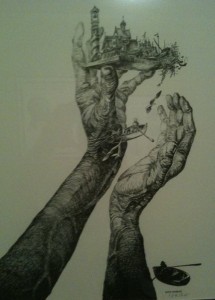Yes there was a long period of time when Christopher and I were in Oklahoma that we saw quite a bit of post-op massage referrals. Haven’t seen too many here yet so I wanted to tell you a bit about it. Most of the time people would make an appointment or let us know when they were scheduled to be discharged so we could be prepared to accommodate them. Sometimes we were requested by the Surgeon to drop by the hospital and see the patient. Sometimes the patient requested it and got permission from their Surgeon to have us come in to the hospital and see them before they were discharged. 
What kills me is people calling just any massage person and asking them to come to the hospital to work with them as if they were ordering a pizza. This is serious business and you have to realize that there are requirements and rules that hospitals have about people coming in and working with their patients. More importantly there are very, very few Massage Therapists that have this level of experience and advanced training to work with post-op patients.
Massage Therapy and Bodywork post-surgery and during rehabilitation is becoming more acceptable as more people experience the benefits. We make adjustments for people who need to be seated, reclining, side lying or otherwise for their comfort. Their comfort is always first.
The American Medical Association’s Archives of Surgery that found that massage, in conjunction with regular pain medication, significantly improved patient pain and anxiety after major surgery. This was published in December 2007 in Time Magazine. A more recent study by Mayo Clinic also showed that patients receiving post-operative massage had a significant reduction in pain, anxiety and tension.
Aside from pain, Lymphatic and Myofascial techniques are also quite effective for post-operative swelling and scar tissue management which will help people heal faster and more functionally overall.
Having our home office location so close to Phoenixville Hospital is a plus however, it doesn’t matter what hospital you have the surgery you can always call 610-906-2322 and make an appointment after surgery.
Here is something for you to consider and share with your Physician.
Position Statement Massage Therapy Can Aid in Postoperative Pain Relief
Approved September 2008
It is the position of the American Massage Therapy Association (AMTA) that massage has been shown to aid in postoperative pain relief.
Background Information
Postoperative pain can complicate and delay a patient’s recovery, lengthen hospital stays and costs, and interfere with a patient’s return to activities of daily living. In many people, pain medications can have unpleasant side effects. Research indicates that massage can decrease postoperative pain, decrease postoperative pain intensity, decrease postoperative pain unpleasantness/distress, decrease sympathetic responses to postoperative pain, accelerate the rate of decline in the intensity of postoperative pain, accelerate the rate of decline of the unpleasantness of postoperative pain, decrease doses of analgesics and increase levels of calmness/feelings of well-being.
References
Janie Franz, The Gale Group Inc. Gale, Detroit, Gale Encyclopedia of Surgery, 2004.
Barnes P, Powell-Griner E, McFann K, Nahin R. CDC Advance Data Report #343. Complementary and Alternative Medicine Use Among Adults: United States, 2002. May 27, 2004.
Mitchinson AR, Kim HM, Rosenberg JM, Geisser M, Kirsh M, Cikrit D, Hinshaw DB. Acute postoperative pain management using massage as an adjuvant therapy: a randomized trial. Arch Surg. 2007 Dec;142(12):1158-67; discussion 1167.
Mehling WE, Jacobs B, Acree M, Wilson L, Bostrom A, West J, Acquah J, Burns B, Chapman J, Hecht FM. Symptom management with massage and acupuncture in postoperative cancer patients: a randomized controlled trial. J Pain Symptom Manage. 2007 Mar; 33(3):258-66.
Kshettry VR, Carole LF, Henly SJ, Sendelbach S, Kummer B. Complementary alternative medical therapies for heart surgery patients: feasibility, safety, and impact. Ann Thorac Surg. 2006 Jan; 81(1):201.
Chen HM, Chang FY, Hsu CT. Effect of acupressure on nausea, vomiting, anxiety and pain among post-cesarean section women in Taiwan. Kaohsiung J Med Sci. 2005 Aug; 21(8):341-50.
Wang HL, Keck JF. Foot and hand massage as an intervention for postoperative pain. Pain Manag Nurs. 2004 Jun; 5(2):59-65.
Piotrowski MM, Paterson C, Mitchinson A, Kim HM, Kirsh M, Hinshaw DB. Massage as adjuvant therapy in the management of acute postoperative pain: a preliminary study in men. J Am Coll Surg. 2003 Dec; 197(6):1037-46.
Taylor AG, Galper DI, Taylor P, Rice LW, Andersen W, Irvin W, Wang XQ, Harrell FE Jr. Effects of adjunctive Swedish massage and vibration therapy on short-term postoperative outcomes: a randomized, controlled trial. J Altern Complement Med. 2003 Feb; 9(1):77-89.
Le Blanc-Louvry I, Costaglioli B, Boulon C, Leroi AM, Ducrotte P. Does mechanical massage of the abdominal wall after colectomy reduce postoperative pain and shorten the duration of ileus? Results of a randomized study. J Gastrointest Surg. 2002 Jan-Feb; 6(1):43-9.
Hattan J, King L, Griffiths P. The impact of foot massage and guided relaxation following cardiac surgery: a randomized controlled trial. J Adv Nurs. 2002 Jan; 37(2):199-207.
Hulme J, Waterman H, Hillier VF. The effect of foot massage on patients’ perception of care following laparoscopic sterilization as day case patients. J Adv Nurs. 1999 Aug; 30(2):460-8.
Nixon M, Teschendorff J, Finney J, Karnilowicz W. Expanding the nursing repertoire: the effect of massage on post-operative pain. Aust J Adv Nurs. 1997 Mar-May; 14(3):21-6.
2005 National Hospital Discharge Survey, Tables 1, 4, 8.
Avalere Health analysis of American Hospital Association Annual Survey data, 2005, for community hospitals. Chart 3.14.
Disclaimer: Position statements of the American Massage Therapy Association (AMTA) are approved by the AMTA House of Delegates and reflect the views and opinions of the association, based on current research. These statements are not expressions of legal opinion relative to scope of practice, medical diagnosis or medical advice, nor do they represent an endorsement of any product, company or specific massage therapy technique, modality or approach.